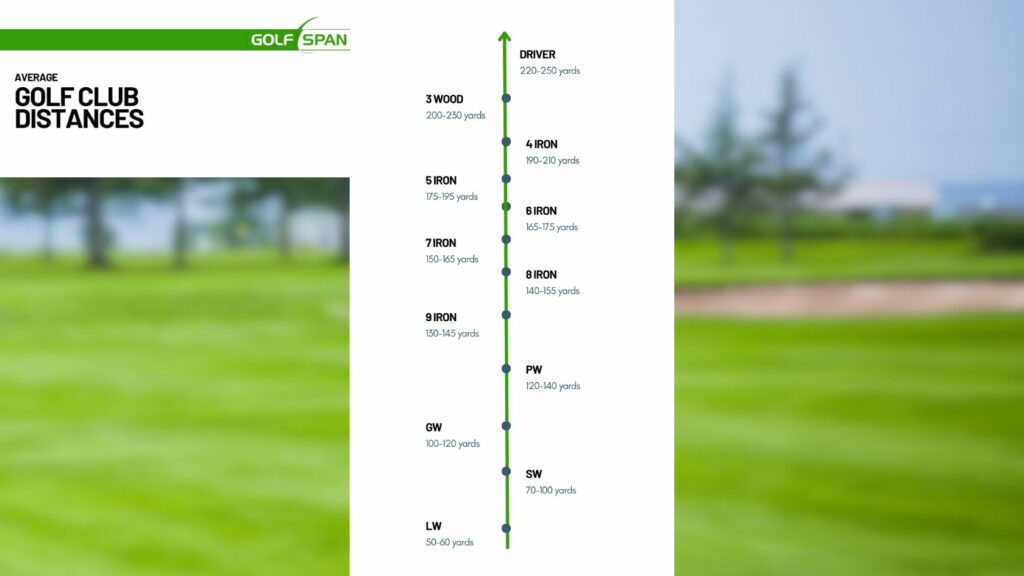Interested in knowing how far you should be able to hit a ball with a specific club? We found out.
Here are some estimated golf club distances a newer golfer could aim for:
- Driver: 225 yards
- 3 Wood: 205 yards
- 5 Wood: 190 yards
- 4 Iron: 175 yards
- 5 Iron: 165 yards
- 6 Iron: 155 yards
- 7 Iron: 145 yards
- 8 Iron: 135 yards
- 9 Iron: 125 yards
- PW: 120 yards
- SW: 90 yards
Your distances will vary, and I advise clients to hit the range with all of your clubs to find your exact distances. Read on because you won’t want to miss the exact approach I recommend so you can choose the right clubs for your game.

Men’s Golf Club Distance Chart
As a general guide, anything above 20 is considered a high handicap, 10-20 is a medium handicapper, and <10 is a low handicapper.
| Club | High Handicappers | Medium Handicappers | Low Handicappers |
| Driver | 200 yards | 260 yards | 270 yards |
| 3-Wood | 180 yards | 240 yards | 250 yards |
| 5-Wood | 170 yards | 220 yards | 240 yards |
| 2-Iron | 160 yards | 200 yards | 220 yards |
| 3-Iron | 150 yards | 190 yards | 200 yards |
| 4-Iron | 140 yards | 180 yards | 190 yards |
| 5-Iron | 130 yards | 170 yards | 180 yards |
| 6-Iron | 120 yards | 160 yards | 170 yards |
| 7-Iron | 110 yards | 150 yards | 160 yards |
| 8-Iron | 100 yards | 140 yards | 150 yards |
| 9-Iron | 90 yards | 130 yards | 140 yards |
| Pitching Wedge | 80 yards | 120 yards | 130 yards |
| Gap Wedge | 60 yards | 110 yards | 120 yards |
| Sand Wedge | 50 yards | 100 yards | 110 yards |
| Lob Wedge | 40 yards | 80 yards | 100 yards |
However, your swing speed will greatly impact your average distance. You’ll also get more distance if you swing faster than the average golfer.
Here are some examples:
Distance By Swing Speed
| Skill Level | Driver Distance | Swing Speed |
| Male Medium handicapper | 220 yards | 94 mph |
| PGA Tour Average | 297 yards | 114 mph |
| Female Medium handicapper | 170 yards | 77 mph |
| LPGA Tour Average | 218 yards | 94 mph |
Note: These golf club distance charts are based on averages according to published data.
Want More Distance? Check Out One Of My Favorite Courses
Get More Distance
Women’s Golf Club Distance Chart
As a general guide, female high handicappers are 35 and above, medium handicappers are 25 – 35, and low handicappers are less than 25.
| Club | High Handicappers | Medium Handicappers | Low Handicappers |
| Driver | 150 yards | 170 yards | 200 yards |
| 3-Wood | 140 yards | 150 yards | 170 yards |
| 5-Wood | 120 yards | 140 yards | 150 yards |
| 2-Iron | 100 yards | 120 yards | 130 yards |
| 3-Iron | 90 yards | 100 yards | 120 yards |
| 4-Iron | 80 yards | 90 yards | 110 yards |
| 5-Iron | 70 yards | 80 yards | 100 yards |
| 6-Iron | 60 yards | 70 yards | 90 yards |
| 7-Iron | 50 yards | 60 yards | 80 yards |
| 8-Iron | 55 yards | 50 yards | 70 yards |
| 9-Iron | 40 yards | 55 yards | 60 yards |
| Pitching Wedge | 45 yards | 40 yards | 50 yards |
| Gap Wedge | 40 yards | 45 yards | 55 yards |
| Sand Wedge | 30 yards | 40 yards | 40 yards |
| Lob Wedge | 30 yards | 30 yards | 30 yards |
PGA Tour Players: Average Golf Club Distances
How do the pros compare to us mere mortals? Here are the facts you can use to impress your buddies.
| Club | Carry distance |
| Driver | 297 yards |
| 3-Wood | 249 yards |
| 5-Wood | 235 yards |
| 3-Iron | 217 yards |
| 4-Iron | 208 yards |
| 5-Iron | 199 yards |
| 6-Iron | 188 yards |
| 7-Iron | 177 yards |
| 8-Iron | 164 yards |
| 9-Iron | 153 yards |
| Pitching Wedge | 141 yards |
| Gap Wedge | 135 yards |
| Sand Wedge | 124 yards |
| Lob Wedge | 105 yards |
Source: PGA Shotlink 2022
But these distances are just the averages. In recent years, LIV golfer Bryson DeChambeau has been the biggest hitter on tour with over 310-yard drives.
Plus, the best data available tracks carry distance for the PGA and LPGA players. Their full shot distances are longer. This distance from the tee to the first bounce does not include the subsequent roll. For example, the average full driver distance on the PGA tour is roughly 320 yards. It’s safe to say that PGA pros drive the ball much further than the average golfer.
However, recently, there’s some news that golf’s governing bodies are trying to limit the drives of the pros.
The USGA and R&A are looking at the massive drives of golf pros and claim it can damage the sport. They propose to limit the pros to using a new type of ball that would reduce most drives by about 15 yards. As you can imagine, many golf pros aren’t happy about this, but Rory supports it.
Of course, amateurs like us don’t need to worry — unless you’re bombing +300-yard drives at your local course.
The expectation of every generation that they’re going to hit it longer than the previous generation, we think that is taking golf in the wrong direction. And we do see some really good opportunities to mitigate these pressures.
LPGA Tour Players: Average Golf Club Distances
The professional ladies can hit further than the male high handicappers as well.
| Club | Carry distance |
| Driver | 218 yards |
| 3-Wood | 195 yards |
| 5-Wood | 185 yards |
| 3-Iron | 174 yards |
| 4-Iron | 169 yards |
| 5-Iron | 161 yards |
| 6-Iron | 152 yards |
| 7-Iron | 141 yards |
| 8-Iron | 130 yards |
| 9-Iron | 119 yards |
| Pitching Wedge | 107 yards |
Source: TrackMan 2022
How To Figure Out Your Golf Club Distance

The fastest way to establish your average distance benchmarks is to record your shots at the driving range. Start with your 7-iron, PW, and driver. If you hit each club 50 times and eliminate the 5 worst and 5 best, that will give you a fairly accurate idea of your average with that club.
I’ve tried this at my local driving range, and it can take a few hours. You’ll also go through plenty of buckets of balls. But that’s time well spent. Now, I’m confident that when choosing clubs, I know how far I’ll be able to hit it. That wasn’t always the case, as I was often unsure, which affected my swing. If you go with a buddy, then this can be a fun and productive way to spend a Saturday.
The same can be done on the course, but it will not be as accurate and will take much longer. Having a great rangefinger and the best golf apps are the way to improve your accuracy. I also use yardage markers. These can vary from course to course but are generally color-coded markers displaying 200 (normally blue), 150 (normally white), and 100 yards (normally red). One can pace backward or forward from the nearest marker to determine your golf club distance.
The best approach is to use both the range and the course and keep track of your averages and progress. This is an excellent exercise for beginner golfers, and keeping a log book or journal of your distances is a good idea.
Read more: If you want to get more distance from your irons, check out our full review of the best player’s distance irons.
Final Thoughts
Golf club distance charts with averages do not give the full picture as there are so many other factors to consider, but they do make for a useful starting point. These charts illustrate the relevant differences between the various club distances across skill levels.
You can take this info and use it as aims to target. But you want to take other factors into account as well.
Of course, there are several things you can do to improve your golf and reduce your score, but knowing your range of golf club distances well will help you make smart decisions on the course. It will take some time and effort but has the potential to dramatically improve your enjoyment of the game as well as your score.
You will have to know your average for your swing and style and with your particular clubs. The saved yards and better lies will still positively impact your results. Of course, it always helps to hit the sweet spot when it comes to distance!
Do it. You won’t regret it.
Read more: For a step-by-step approach to getting more distance from your driver, check out our full article.
Clint is PGA-certified and was a Head Teaching Professional at one of Toronto's busiest golf academies. He was also featured on Canada's National Golf TV program, "Score Golf Canada," twice. He graduated with a degree in Golf Management from the College of the Desert in California and studied under Callaway's co-founder, Tony Manzoni. He has a handicap index of 6.2 and spends the winters near Oaxaca, Mexico, where he plays twice a month at the Club de Golf Vista Hermosa. He's written over 100 articles at GolfSpan since 2021. You can connect with Clint at LinkedIn, FB, his website, or Clintcpga@gmail.com.








